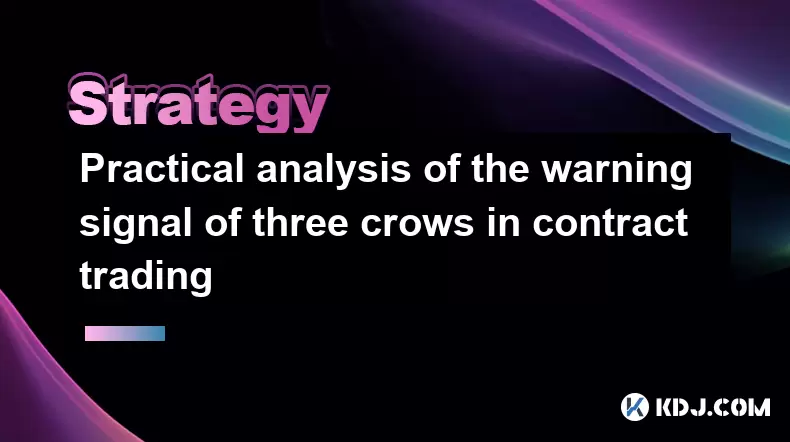-
 bitcoin
bitcoin $114320.977035 USD
-0.40% -
 ethereum
ethereum $4152.439985 USD
-1.75% -
 tether
tether $1.000111 USD
-0.04% -
 xrp
xrp $2.843037 USD
-1.63% -
 bnb
bnb $1013.349380 USD
-1.62% -
 solana
solana $208.362767 USD
-2.10% -
 usd-coin
usd-coin $0.999783 USD
0.00% -
 dogecoin
dogecoin $0.232559 USD
-1.00% -
 tron
tron $0.333491 USD
-1.09% -
 cardano
cardano $0.806310 USD
0.19% -
 hyperliquid
hyperliquid $45.023720 USD
-1.59% -
 ethena-usde
ethena-usde $1.000819 USD
-0.06% -
 chainlink
chainlink $21.241249 USD
-2.11% -
 avalanche
avalanche $30.035416 USD
-0.66% -
 stellar
stellar $0.364984 USD
-2.05%
Practical analysis of the warning signal of three crows in contract trading
Three crows pattern in crypto trading signals a bearish reversal; traders should confirm with volume and consider short positions or exiting longs.
Jun 05, 2025 at 09:07 pm

In the realm of contract trading within the cryptocurrency market, traders often rely on various technical analysis tools to guide their decisions. One such tool is the candlestick pattern known as 'three crows,' which serves as a bearish warning signal. This article delves into a practical analysis of this pattern, explaining its formation, significance, and application in contract trading.
Understanding the Three Crows Pattern
The three crows pattern is a bearish reversal pattern that appears at the end of an uptrend. It is characterized by three consecutive long-bodied bearish candles, each opening within the body of the previous candle and closing near its low. This formation indicates a strong shift in market sentiment from bullish to bearish, suggesting that the uptrend may be exhausted and a reversal could be imminent.
Formation of the Three Crows
To identify the three crows pattern, traders must observe the following characteristics in the candlestick chart:
- First Candle: A long bearish candle that opens within the body of the preceding bullish candle and closes near its low.
- Second Candle: Another long bearish candle that opens within the body of the first bearish candle and also closes near its low.
- Third Candle: A third long bearish candle that opens within the body of the second bearish candle and closes near its low.
Each candle in the sequence should have minimal upper shadows, emphasizing the bearish pressure and the sellers' control over the market.
Significance of the Three Crows in Contract Trading
In contract trading, where positions can be leveraged to amplify gains or losses, recognizing the three crows pattern can be crucial. This pattern signals that the market might be entering a downtrend, prompting traders to consider exiting long positions or entering short positions. The significance of this pattern lies in its ability to provide a clear visual cue of a potential reversal, allowing traders to adjust their strategies accordingly.
Practical Application in Contract Trading
Applying the three crows pattern in contract trading involves several steps that traders should follow to maximize its effectiveness:
- Observation: Monitor the price action of the cryptocurrency you are trading, particularly during an uptrend. Look for the formation of the first bearish candle that opens within the body of a preceding bullish candle.
- Confirmation: Wait for the second and third bearish candles to form, ensuring they meet the criteria of the three crows pattern. Confirm that each subsequent candle opens within the body of the previous one and closes near its low.
- Decision Making: Once the pattern is confirmed, consider the following actions:
- If you are holding a long position, assess whether it is time to close it to avoid potential losses.
- If you are considering entering a new position, evaluate the possibility of entering a short position to capitalize on the expected downtrend.
- Risk Management: Always apply appropriate risk management techniques, such as setting stop-loss orders, to protect your capital in case the market does not move as anticipated.
Examples of Three Crows in Cryptocurrency Markets
To illustrate the practical application of the three crows pattern, consider the following hypothetical examples from the cryptocurrency market:
- Bitcoin (BTC) Example: Imagine Bitcoin is in a strong uptrend, reaching a peak at $50,000. The first bearish candle opens at $49,500 and closes at $48,000. The second candle opens at $48,500 and closes at $47,000. The third candle opens at $47,500 and closes at $46,000. This formation of three crows suggests that the uptrend may be reversing, and traders might consider shorting Bitcoin or exiting long positions.
- Ethereum (ETH) Example: Ethereum is trading upwards, reaching $3,000. The first bearish candle opens at $2,950 and closes at $2,800. The second candle opens at $2,850 and closes at $2,700. The third candle opens at $2,750 and closes at $2,600. This pattern indicates a potential reversal, prompting traders to adjust their positions accordingly.
Limitations and Considerations
While the three crows pattern can be a powerful tool, it is not infallible. Traders should consider the following limitations and factors:
- Market Context: The pattern should be evaluated within the broader market context. For instance, if there are significant bullish news or events expected, the pattern might be less reliable.
- Volume: Confirm the pattern with trading volume. Higher volume during the formation of the three crows can validate the bearish sentiment.
- Confirmation: Wait for additional bearish signals, such as a break below a key support level, to increase the probability of a successful trade.
Frequently Asked Questions
Q1: Can the three crows pattern be used in other financial markets besides cryptocurrency?Yes, the three crows pattern is a universal technical analysis tool that can be applied to various financial markets, including stocks, forex, and commodities. The principles of identifying and interpreting the pattern remain the same across different markets.
Q2: How can traders differentiate the three crows pattern from other bearish candlestick patterns?The three crows pattern is unique due to its requirement of three consecutive long-bodied bearish candles, each opening within the body of the previous candle and closing near its low. Other bearish patterns, like the evening star or bearish engulfing, have different formations and criteria.
Q3: Is it necessary to use additional technical indicators alongside the three crows pattern?While the three crows pattern can be used standalone, combining it with other technical indicators, such as moving averages, RSI, or MACD, can enhance its reliability and provide a more comprehensive view of market conditions.
Q4: How long should traders wait for the three crows pattern to fully develop before acting?Traders should wait until the third bearish candle has closed to confirm the pattern. Acting prematurely can lead to false signals. However, once the pattern is confirmed, swift action is recommended to capitalize on the potential downtrend.
Disclaimer:info@kdj.com
The information provided is not trading advice. kdj.com does not assume any responsibility for any investments made based on the information provided in this article. Cryptocurrencies are highly volatile and it is highly recommended that you invest with caution after thorough research!
If you believe that the content used on this website infringes your copyright, please contact us immediately (info@kdj.com) and we will delete it promptly.
- BlockDAG, DOGE, HYPE Sponsorship: Crypto Trends Shaping 2025
- 2025-10-01 00:25:13
- Deutsche Börse and Circle: A StableCoin Adoption Powerhouse in Europe
- 2025-10-01 00:25:13
- BlockDAG's Presale Buzz: Is It the Crypto to Watch in October 2025?
- 2025-10-01 00:30:13
- Bitcoin, Crypto, and IQ: When Genius Meets Digital Gold?
- 2025-10-01 00:30:13
- Stablecoins, American Innovation, and Wallet Tokens: The Next Frontier
- 2025-10-01 00:35:12
- NBU, Coins, and Crypto in Ukraine: A New Yorker's Take
- 2025-10-01 00:45:14
Related knowledge

Practical parameter settings for a Bitcoin multi-timeframe moving average system
Sep 18,2025 at 10:54pm
Optimizing Timeframe Combinations for Bitcoin Trading1. Selecting appropriate timeframes is crucial when building a multi-timeframe moving average sys...

How can I filter out false breakouts in Dogecoin high-frequency trading?
Sep 22,2025 at 01:00am
Understanding False Breakouts in Dogecoin Trading1. A false breakout occurs when Dogecoin's price appears to move beyond a defined support or resistan...

Techniques for identifying tops and bottoms in the Bitcoin on-chain NVT model
Sep 20,2025 at 07:54pm
Understanding the NVT Model in Bitcoin Analysis1. The Network Value to Transactions (NVT) ratio is often described as the 'P/E ratio' of the cryptocur...

What does the surge in open interest in Bitcoincoin futures mean?
Sep 20,2025 at 11:18pm
Understanding the Surge in Dogecoin Futures Open Interest1. A surge in open interest within Dogecoin futures indicates a growing number of active cont...

How can I use the Ethereum USDT premium to gauge market sentiment?
Sep 18,2025 at 11:55pm
Understanding the Ethereum USDT Premium1. The Ethereum USDT premium refers to the price difference between USDT (Tether) traded on Ethereum-based plat...

What should I do if Ethereum staking yields decline?
Sep 20,2025 at 06:18am
Understanding the Causes Behind Declining Ethereum Staking Yields1. The Ethereum network transitioned to a proof-of-stake consensus mechanism with the...

Practical parameter settings for a Bitcoin multi-timeframe moving average system
Sep 18,2025 at 10:54pm
Optimizing Timeframe Combinations for Bitcoin Trading1. Selecting appropriate timeframes is crucial when building a multi-timeframe moving average sys...

How can I filter out false breakouts in Dogecoin high-frequency trading?
Sep 22,2025 at 01:00am
Understanding False Breakouts in Dogecoin Trading1. A false breakout occurs when Dogecoin's price appears to move beyond a defined support or resistan...

Techniques for identifying tops and bottoms in the Bitcoin on-chain NVT model
Sep 20,2025 at 07:54pm
Understanding the NVT Model in Bitcoin Analysis1. The Network Value to Transactions (NVT) ratio is often described as the 'P/E ratio' of the cryptocur...

What does the surge in open interest in Bitcoincoin futures mean?
Sep 20,2025 at 11:18pm
Understanding the Surge in Dogecoin Futures Open Interest1. A surge in open interest within Dogecoin futures indicates a growing number of active cont...

How can I use the Ethereum USDT premium to gauge market sentiment?
Sep 18,2025 at 11:55pm
Understanding the Ethereum USDT Premium1. The Ethereum USDT premium refers to the price difference between USDT (Tether) traded on Ethereum-based plat...

What should I do if Ethereum staking yields decline?
Sep 20,2025 at 06:18am
Understanding the Causes Behind Declining Ethereum Staking Yields1. The Ethereum network transitioned to a proof-of-stake consensus mechanism with the...
See all articles










































































